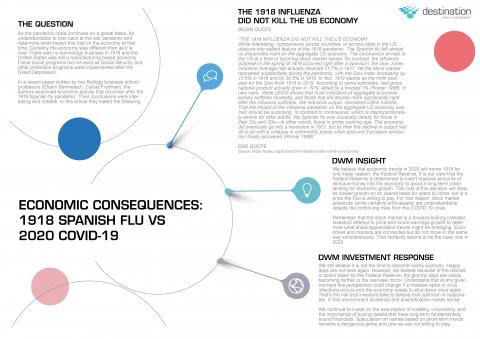Economic Consequences: 1918 Spanish Flu vs 2020 COVID-19
Our new weekly format is designed to provide a clear description of the issue being discussed, our comments regarding that issue, and the investable action related to our conclusion. This will be the format going forward and should provide an easier and clearer communication of our insights to you. We hope you find this new format helpful.
The Question
As the pandemic crisis continues on a global basis, it's understandable to look back at the last pandemic and determine what impact this had on the economy at that time. Certainly, the economy was different then as it is now. There was no technology business in 1918 and the United States was still a manufacturing-based economy. Fiscal social programs did not exist as Social Security and other protection programs were implemented after the Great Depression.
In a recent paper written by two Kellogg business school professors (Efraim Benmelech, Carola Frydman), the authors examined economic activity that occurred after the 1918 Spanish flu pandemic. Their conclusions were interesting and notable. In this article they stated the following:
***
Begin Quote
While interesting, comparisons across countries, or across cities in the US, obscure one salient feature of the 1918 pandemic. The Spanish flu left almost no discernible mark on the aggregate US economy. The coronavirus arrived to the US at a time of booming stock market values. By contrast, the influenza outbreak in the spring of 1918 occurred right after a downturn: the Dow Jones Industrial Average had actually declined 21.7% in 1917. Yet the stock market recovered substantially during the pandemic, with the Dow index increasing by 10.5% in 1918 and by 30.5% in 1919.
In fact, 1919 stands as the ninth best year for the Dow from 1915 to 2019. According to some estimates, real gross national product actually grew in 1919, albeit by a modest 1% (Romer 1988). In new work, Velde (2020) shows that most indicators of aggregate economic activity suffered modestly, and those that did decline more significantly right after the influenza outbreak, like industrial output, recovered within months.
That the impact of the influenza pandemic on the aggregate US economy was mild should be surprising. In contrast to coronavirus, which is disproportionately severe for older adults, the Spanish flu was unusually deadly for those in their 20s and 30s—in other words, those in prime working age. The economy did eventually go into a recession in 1921, but by then the decline in output had all to do with a collapse in commodity prices when post-war European production finally recovered (Romer 1988).
Source: https://voxeu.org/article/1918-influenza-did-not-kill-us-economy
End Quote
***
DWM Insight
We believe that economic trends in 2020 will mirror 1918 for one major reason: The Federal Reserve. It is our view that the Federal Reserve is determined to insert massive amounts of stimulus money into the economy to avoid a long-term crash landing for economic growth. The cost of this decision will likely be slower growth on an overall basis for years to come but is a price the Fed is willing to pay. For that reason, stock market advances (while certainly enthusiastic) are understandable despite the continuing risks from the COVID 19 crisis.
Remember that the stock market is a forward-looking indicator. Investors attempt to price and future earnings growth to determine what share appreciation trends might be emerging. Economies and markets are connected but do not move in the same way simultaneously. That certainly seems to be the case now in 2020.
DWM Investment Response
We still believe it is not the time to become overly euphoric. Happy days are not here again. However, we believe because of the dramatic action taken by the Federal Reserve, the gloomy days are slowly becoming farther in the rearview mirror. Understand that at any given moment this perspective could change if a massive spike in virus infections occurs and the economy needs to shut down once again. That's the risk that investors take to believe that optimism is reasonable. In this environment dividends and diversification makes sense.
We continue to invest on the assumption of volatility, uncertainty, and the importance of buying assets that have long-term fundamentally sound financials. Speculation on names based on short-term trends remains a dangerous game and one we are not willing to play.
The opinions expressed herein are provided for informational purposes only and are not intended as investment advice. All investments involve risk, including loss of principal invested. Past performance does not guarantee future performance. Individual client accounts may vary. Although the information provided to you on this site is obtained or compiled from sources we believe to be reliable, Destination Wealth Management cannot and does not guarantee the accuracy, validity, timeliness or completeness of any information or data made available to you for any particular purpose. Any links to other websites are used at your own risk.



